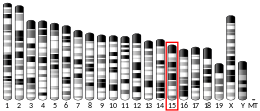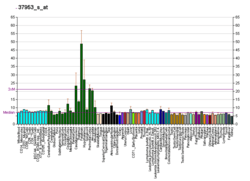ASIC1
Acid-sensing ion channel 1 (ASIC1) also known as amiloride-sensitive cation channel 2, neuronal (ACCN2) or brain sodium channel 2 (BNaC2) is a protein that in humans is encoded by the ASIC1 gene. The ASIC1 gene is one of the five paralogous genes that encode proteins that form trimeric acid-sensing ion channels (ASICs) in mammals.[5] The cDNA of this gene was first cloned in 1996.[6] The ASIC genes have splicing variants that encode different proteins that are called isoforms.
These genes are mainly expressed in the central and peripheral nervous system.
ASICs can form both homotrimeric (meaning composed of three identical subunits) and heterotrimeric channels.[7][8]
Structure and function
This gene encodes a member of the ASIC/ENaC superfamily of proteins.[9] The members of this family are amiloride-sensitive sodium channels that contain intracellular N and C termini, 2 hydrophobic transmembrane (TM) regions, and a large extracellular loop, which has many cysteine residues with conserved spacing. The TM regions are generally symbolized as TM1 (clone to N-terminus) and TM2 (close to C-terminus).
The pore of the channel through which ions selectively flow from the extracellular side into the cytoplasm is formed by the three TM2 regions of the trimer.[5]
Interactions
ASIC1 has been shown to interact with PICK1.[10][11]
References
- GRCh38: Ensembl release 89: ENSG00000110881 - Ensembl, May 2017
- GRCm38: Ensembl release 89: ENSMUSG00000023017 - Ensembl, May 2017
- "Human PubMed Reference:". National Center for Biotechnology Information, U.S. National Library of Medicine.
- "Mouse PubMed Reference:". National Center for Biotechnology Information, U.S. National Library of Medicine.
- Hanukoglu I (2017). "ASIC and ENaC type sodium channels: Conformational states and the structures of the ion selectivity filters". FEBS Journal. 284 (4): 525–545. doi:10.1111/febs.13840. PMID 27580245.
- García-Añoveros J, Derfler B, Neville-Golden J, Hyman BT, Corey DP (March 1997). "BNaC1 and BNaC2 constitute a new family of human neuronal sodium channels related to degenerins and epithelial sodium channels". Proc Natl Acad Sci U S A. 94 (4): 1459–64. Bibcode:1997PNAS...94.1459G. doi:10.1073/pnas.94.4.1459. PMC 19813. PMID 9037075.
- Babinski K, Catarsi S, Biagini G, Séguéla P (Sep 2000). "Mammalian ASIC2a and ASIC3 subunits co-assemble into heteromeric proton-gated channels sensitive to Gd3+". The Journal of Biological Chemistry. 275 (37): 28519–25. doi:10.1074/jbc.M004114200. PMID 10842183.
- Bassilana F, Champigny G, Waldmann R, de Weille JR, Heurteaux C, Lazdunski M (Nov 1997). "The acid-sensitive ionic channel subunit ASIC and the mammalian degenerin MDEG form a heteromultimeric H+-gated Na+ channel with novel properties". The Journal of Biological Chemistry. 272 (46): 28819–22. doi:10.1074/jbc.272.46.28819. PMID 9360943.
- Hanukoglu I, Hanukoglu A (Jan 2016). "Epithelial sodium channel (ENaC) family: Phylogeny, structure-function, tissue distribution, and associated inherited diseases". Gene. 579 (2): 95–132. doi:10.1016/j.gene.2015.12.061. PMC 4756657. PMID 26772908.
- Leonard AS, Yermolaieva O, Hruska-Hageman A, Askwith CC, Price MP, Wemmie JA, Welsh MJ (February 2003). "cAMP-dependent protein kinase phosphorylation of the acid-sensing ion channel-1 regulates its binding to the protein interacting with C-kinase-1". Proc. Natl. Acad. Sci. U.S.A. 100 (4): 2029–34. Bibcode:2003PNAS..100.2029L. doi:10.1073/pnas.252782799. PMC 149953. PMID 12578970.
- Hruska-Hageman AM, Wemmie JA, Price MP, Welsh MJ (February 2002). "Interaction of the synaptic protein PICK1 (protein interacting with C kinase 1) with the non-voltage gated sodium channels BNC1 (brain Na+ channel 1) and ASIC (acid-sensing ion channel)". Biochem. J. 361 (Pt 3): 443–50. doi:10.1042/0264-6021:3610443. PMC 1222326. PMID 11802773.
Further reading
- Corey DP, García-Añoveros J (1996). "Mechanosensation and the DEG/ENaC ion channels". Science. 273 (5273): 323–4. Bibcode:1996Sci...273..323C. doi:10.1126/science.273.5273.323. PMID 8685718.
- Waldmann R, Champigny G, Bassilana F, Heurteaux C, Lazdunski M (1997). "A proton-gated cation channel involved in acid-sensing". Nature. 386 (6621): 173–7. Bibcode:1997Natur.386..173W. doi:10.1038/386173a0. PMID 9062189.
- Bubien JK, Keeton DA, Fuller CM, Gillespie GY, Reddy AT, Mapstone TB, Benos DJ (1999). "Malignant human gliomas express an amiloride-sensitive Na+ conductance". Am. J. Physiol. 276 (6 Pt 1): C1405–10. doi:10.1152/ajpcell.1999.276.6.C1405. PMID 10362604.
- Askwith CC, Cheng C, Ikuma M, Benson C, Price MP, Welsh MJ (2000). "Neuropeptide FF and FMRFamide potentiate acid-evoked currents from sensory neurons and proton-gated DEG/ENaC channels". Neuron. 26 (1): 133–41. doi:10.1016/S0896-6273(00)81144-7. PMID 10798398.
- Bässler EL, Ngo-Anh TJ, Geisler HS, Ruppersberg JP, Gründer S (2001). "Molecular and functional characterization of acid-sensing ion channel (ASIC) 1b". J. Biol. Chem. 276 (36): 33782–7. doi:10.1074/jbc.M104030200. PMID 11448963.
- Gunthorpe MJ, Smith GD, Davis JB, Randall AD (2001). "Characterisation of a human acid-sensing ion channel (hASIC1a) endogenously expressed in HEK293 cells". Pflügers Arch. 442 (5): 668–74. doi:10.1007/s004240100584. PMID 11512022.
- Duggan A, Garcia-Anoveros J, Corey DP (2002). "The PDZ domain protein PICK1 and the sodium channel BNaC1 interact and localize at mechanosensory terminals of dorsal root ganglion neurons and dendrites of central neurons". J. Biol. Chem. 277 (7): 5203–8. doi:10.1074/jbc.M104748200. PMID 11739374.
- Ji HL, Jovov B, Fu J, Bishop LR, Mebane HC, Fuller CM, Stanton BA, Benos DJ (2002). "Up-regulation of acid-gated Na(+) channels (ASICs) by cystic fibrosis transmembrane conductance regulator co-expression in Xenopus oocytes". J. Biol. Chem. 277 (10): 8395–405. doi:10.1074/jbc.M109465200. PMID 11748227.
- Hruska-Hageman AM, Wemmie JA, Price MP, Welsh MJ (2002). "Interaction of the synaptic protein PICK1 (protein interacting with C kinase 1) with the non-voltage gated sodium channels BNC1 (brain Na+ channel 1) and ASIC (acid-sensing ion channel)". Biochem. J. 361 (Pt 3): 443–50. doi:10.1042/0264-6021:3610443. PMC 1222326. PMID 11802773.
- Wemmie JA, Chen J, Askwith CC, Hruska-Hageman AM, Price MP, Nolan BC, Yoder PG, Lamani E, Hoshi T, Freeman JH, Welsh MJ (2002). "The acid-activated ion channel ASIC contributes to synaptic plasticity, learning, and memory". Neuron. 34 (3): 463–77. doi:10.1016/S0896-6273(02)00661-X. PMID 11988176.
- Berdiev BK, Xia J, Jovov B, Markert JM, Mapstone TB, Gillespie GY, Fuller CM, Bubien JK, Benos DJ (2003). "Protein kinase C isoform antagonism controls BNaC2 (ASIC1) function". J. Biol. Chem. 277 (48): 45734–40. doi:10.1074/jbc.M208995200. PMID 12244121.
- Ugawa S, Ueda T, Ishida Y, Nishigaki M, Shibata Y, Shimada S (2002). "Amiloride-blockable acid-sensing ion channels are leading acid sensors expressed in human nociceptors". J. Clin. Invest. 110 (8): 1185–90. doi:10.1172/JCI15709. PMC 150796. PMID 12393854.
- Leonard AS, Yermolaieva O, Hruska-Hageman A, Askwith CC, Price MP, Wemmie JA, Welsh MJ (2003). "cAMP-dependent protein kinase phosphorylation of the acid-sensing ion channel-1 regulates its binding to the protein interacting with C-kinase-1". Proc. Natl. Acad. Sci. U.S.A. 100 (4): 2029–34. Bibcode:2003PNAS..100.2029L. doi:10.1073/pnas.252782799. PMC 149953. PMID 12578970.
- Wemmie JA, Coryell MW, Askwith CC, Lamani E, Leonard AS, Sigmund CD, Welsh MJ (2004). "Overexpression of acid-sensing ion channel 1a in transgenic mice increases acquired fear-related behavior". Proc. Natl. Acad. Sci. U.S.A. 101 (10): 3621–6. Bibcode:2004PNAS..101.3621W. doi:10.1073/pnas.0308753101. PMC 373512. PMID 14988500.
- Poirot O, Vukicevic M, Boesch A, Kellenberger S (2004). "Selective regulation of acid-sensing ion channel 1 by serine proteases". J. Biol. Chem. 279 (37): 38448–57. doi:10.1074/jbc.M407381200. PMID 15247234.
- Price MP, Thompson RJ, Eshcol JO, Wemmie JA, Benson CJ (2005). "Stomatin modulates gating of acid-sensing ion channels". J. Biol. Chem. 279 (51): 53886–91. doi:10.1074/jbc.M407708200. PMID 15471860.





